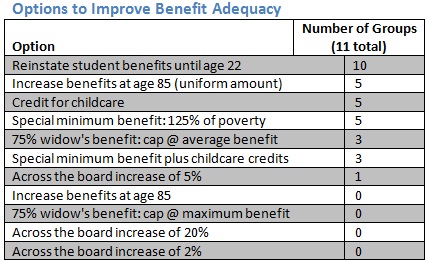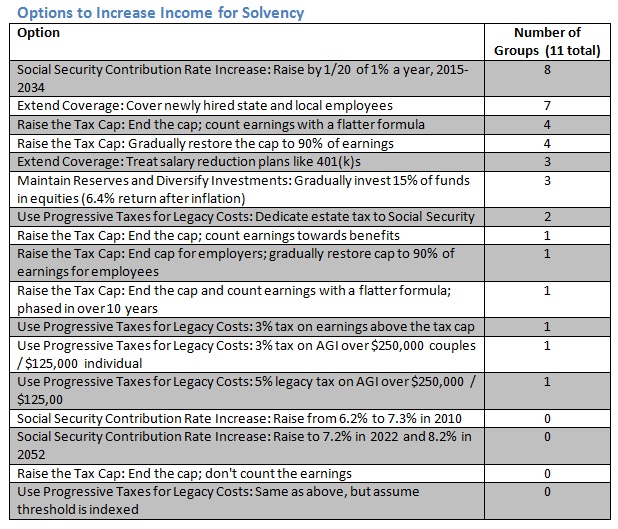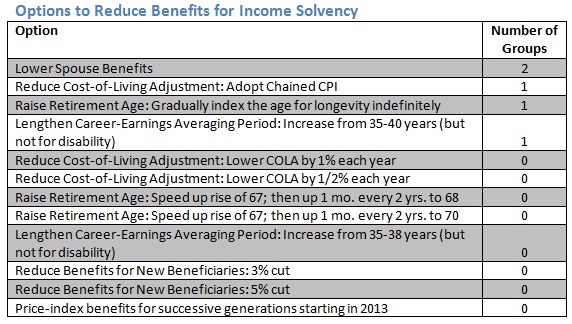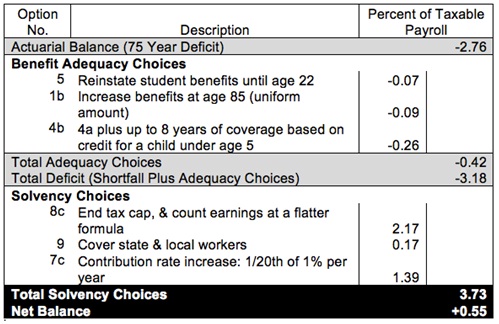Chidi Ahaghotu, Halley Brunsteter, and Tessa Conroy
Every year the National Academy of Social Insurance (NASI) hosts Demystifying Social Security, a day-long academy for young people in Washington, DC. During the event, attendees are asked to consider policy options for reform that would determine the future of Social Security. The results indicate that young people, like other Americans, value Social Security and support moderate policy reform to strengthen the program.
These views on Social Security are consistent with broader surveys of the American public such as those conducted by NASI and the Institute for Women’s Policy Research.
NASI’s annual summer academy in Washington, DC, was developed to educate interns, young professionals, and students on Social Security. With the projected depletion of the Social Security trust fund, the attendees were asked about policies that address adequate coverage for Social Security beneficiaries, as well as the program’s financial solvency. The 100 participants were each given a copy of NASI’s Fixing Social Security: Adequate Benefits, Adequate Financing and a worksheet with blanks for solvency and adequacy options. They were then divided into eleven groups and asked to discuss and produce a budget-balancing package.
The Results: The 2012 Summer Academy Policy Package
Based on this exercise, the attendees at the 2012 Social Security Intern Academy decided on a plan to address Social Security’s solvency and adequacy as follows:
The 2012 Social Security Academy focused on policies that both improve the adequacy of benefits and increase Social Security’s revenues. Since participants were asked to address adequacy in addition to solvency options and benefit reductions, these results reveal an additional layer of public opinion that many public opinion polls neglect. The young professionals overwhelmingly opted not to cut benefits. The two main focuses of their package are as follows: improve the adequacy of the benefits and improve solvency through increasing revenue.
Options to Improve Benefit Adequacy
The adequacy of Social Security’s benefits was discussed because benefit amounts are modest, and much of America’s aging population, as well as many disabled workers, rely on Social Security’s benefits. That reliance has intensified since the beginning of the recession in late 2007. Compounding this problem, the modest benefits have not kept up with rising health care and housing costs faced by many Americans. Perhaps due to this gap, ten of the eleven groups supported at least one of the options to increase the adequacy of benefits. The groups tended to support adequacy options that increase benefits for vulnerable groups including children, the poor, and the oldest of the old. These populations were targeted through the following most popular options:
- Reinstate Student Benefits until the Child is 22. Many of the groups’ representatives spoke about how the minor expenditure could improve the living situation and educational attainment of many underprivileged students. Ten of the eleven groups opted to reinstate student benefits for the child survivor of a deceased parent until age 22, if they are attending college or vocational school.
- Provide Childcare Credits in the Regular Benefit Formula. In order to recognize the time that many women spend out of the workforce caring for children, this option would grant up to five years of wage credits (at one half of the average wage) to workers with a child is under age six and with no other earnings that year. Five of the eleven of the groups included childcare credits in their package.
- Update the Special Minimum Benefit to 125% of Poverty at Full- Benefit Age for a 30-Year Worker. This option would create a minimum benefit amount based on years of work, so that people who worked a full career at low wages could retire and receive a benefit that’s at least above poverty. Five of the eleven groups decided to update the special minimum benefit.
- Increase Benefits at Age 85. The oldest of the old are more likely to become financially unstable the longer they live. Five out of the eleven groups thought they should increase benefits for those who lived past 85 years of age.

Options to Increase Revenue for Solvency
Since its beginning, Social Security has been financed as a “pay as you go” system, which means that current contributions of current workers fund the benefits of current retirees. As the baby boomer generation ages, the number of workers per beneficiary falls, which has led many to question the future financing of the program. To address the issue of solvency, the following four policy options were chosen by the NASI Summer 2012 Academy participants:
- Schedule a Very Gradual Contribution Rate Increase Over 20 Years. Beginning in 2015, this option would very gradually increase the contribution rate of workers by 1/20th of one percent per year for 20 years. Eight out of the eleven groups were in favor of this option because it increased revenue to the system while not abruptly increasing the tax rate.
- Extend Social Security Coverage to Newly Hired Non-Covered State and Local Government Employees. Although almost all workers are covered under Social Security, 25% of state and local workers are not. Seven out of the eleven groups thought that the inclusion of these workers could aid in Social Security’s financial solvency. However, many groups pointed out that this might put a strain on state and local governments during the transition period.
- Gradually Restore the Tax Cap to 90% of All Earnings. If a worker makes more than $110,100 per year, anything above that amount is not taxed under the current tax cap. Restoring the cap to cover 90% of all earnings would mean that the top 6% of earners would pay more. For the rest (94%) of the covered workers, there would be no change at all. Four of the eleven groups chose this option.
- End Tax Cap & Count Earnings at a Flatter Rate. This option would completely eliminate the tax cap and make all earnings taxable for Social Security. The additional earnings above the current tax cap would count toward benefits at a flatter rate. This means higher income beneficiaries would pay more in Social Security taxes, and they would also receive a slight increase in their benefits to reflect that. For the 94% of covered workers who earn below the current tax cap, there would be no change at all. Four out of the eleven groups chose this option.

The consensus reached by these groups shows that young people are committed to maintaining the effectiveness of Social Security and ensuring its presence for future generations. The groups tended to highlight revenue-generating options and benefit expansions in their plans; only four groups at the Social Security academy included a benefit reduction option in their packages. The most popular benefit reduction option, lowering the spousal benefit, was only adopted by two tables. The other options, which were adopted by one table each, include benefit reduction options most often discussed among policymakers: switching to a chained CPI and raising the retirement age. This preference for maintaining benefits implies that attendees value Social Security as it is and would rather increase revenues than cut benefits.

Visit NASI’s events page to download materials from Demystifying Social Security: 2012 Summer Academy.
The authors were NASI interns for Summer 2012. Chidi Ahaghotu, 2012 Somers Aging and Long‐Term Care Research intern, interned with U.S. Department of Health & Human Services‐Office of the Assistant Secretary for Planning & Evaluation, Halley Brunsteter interned with AcademyHealth, and Tessa Conroy interned with the Congressional Research Service. For more information on NASI’s summer internship programs, visit the Student Opportunities page.

